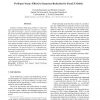Free Online Productivity Tools
i2Speak
i2Symbol
i2OCR
iTex2Img
iWeb2Print
iWeb2Shot
i2Type
iPdf2Split
iPdf2Merge
i2Bopomofo
i2Arabic
i2Style
i2Image
i2PDF
iLatex2Rtf
Sci2ools
73
Voted
TASE
2008
IEEE
2008
IEEE
ProB gets Nauty: Effective Symmetry Reduction for B and Z Models
Symmetry reduction holds great promise to counter the state explosion problem. However, currently it is “conducting a life on the fringe”, and is not widely applied, mainly due to the restricted applicability of many of the techniques. In this paper we propose a symmetry reduction technique applied to high-level formal specification languages (B and Z). Not only does symmetry arise naturally in most models, it can also be exploited without restriction by our method. This method translates states of a formal model into directed graphs, and then uses graph canonicalisation to detect symmetries. We use the tool NAUTY to efficiently perform graph canonicalisation, which we have interfaced with the model checker PROB. In this paper we present the general technique, show how states can be translated first into vertex-coloured graphs suitable for NAUTY. We present empirical results, showing the effectiveness of our method as well as analysing the cost of graph canonicalisation.
Graph Canonicalisation | Software Engineering | Symmetry Reduction | Symmetry Reduction Technique | TASE 2008 |
| Added | 01 Jun 2010 |
| Updated | 01 Jun 2010 |
| Type | Conference |
| Year | 2008 |
| Where | TASE |
| Authors | Corinna Spermann, Michael Leuschel |
Comments (0)

